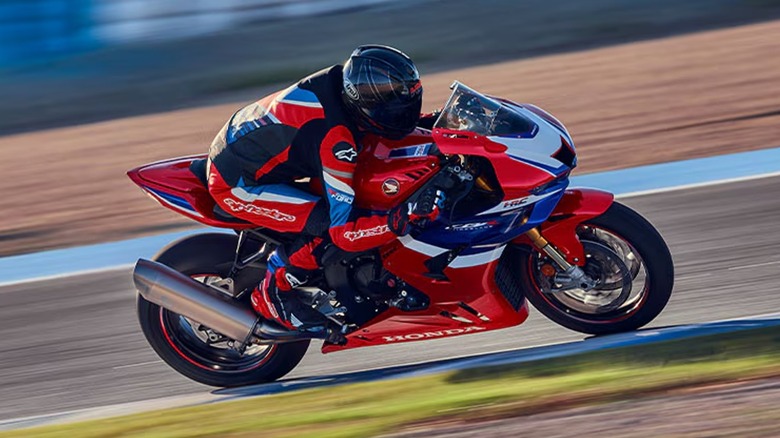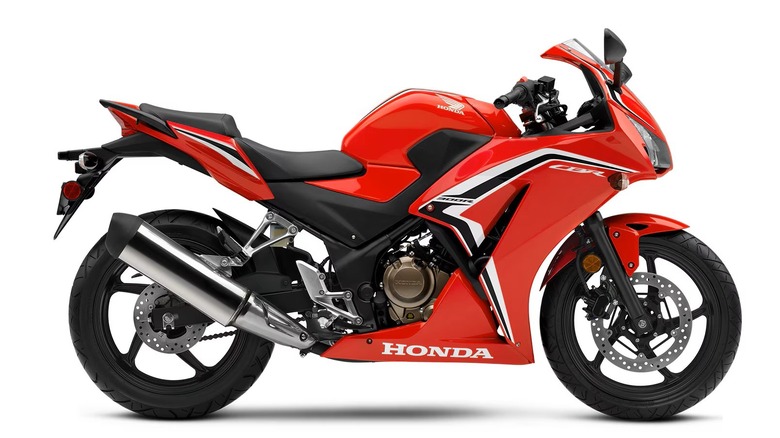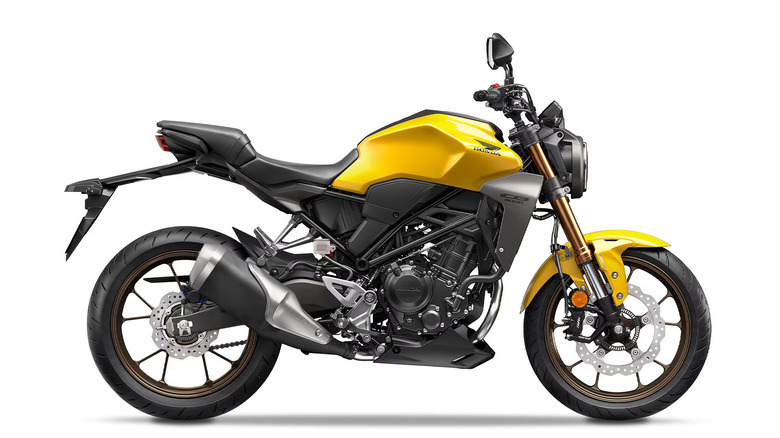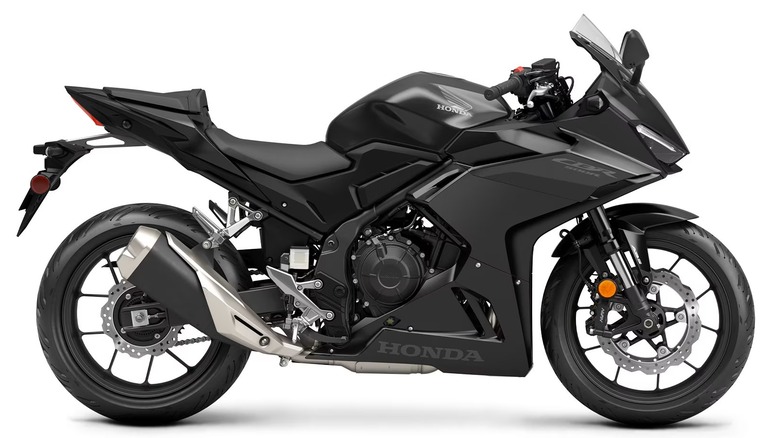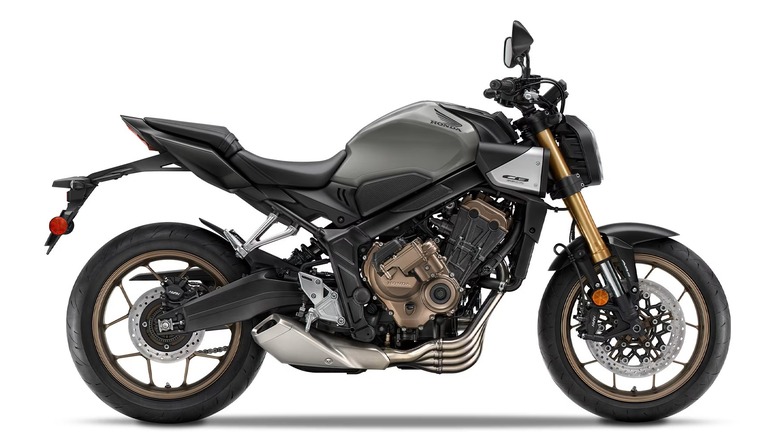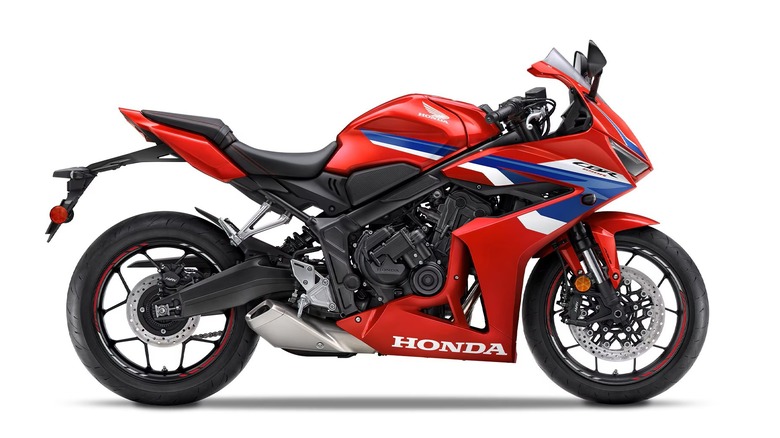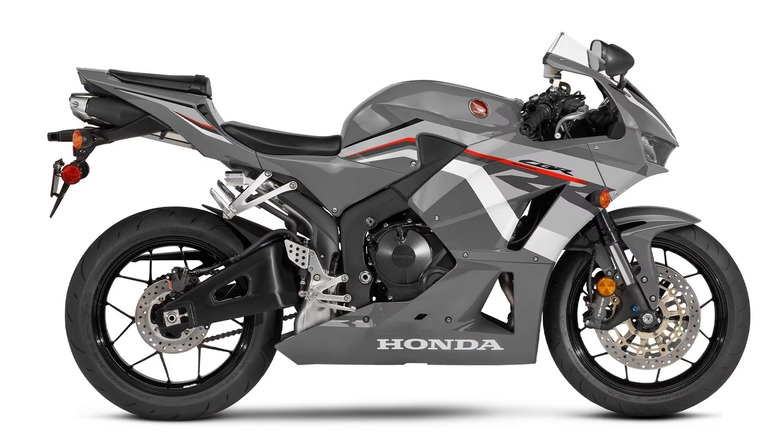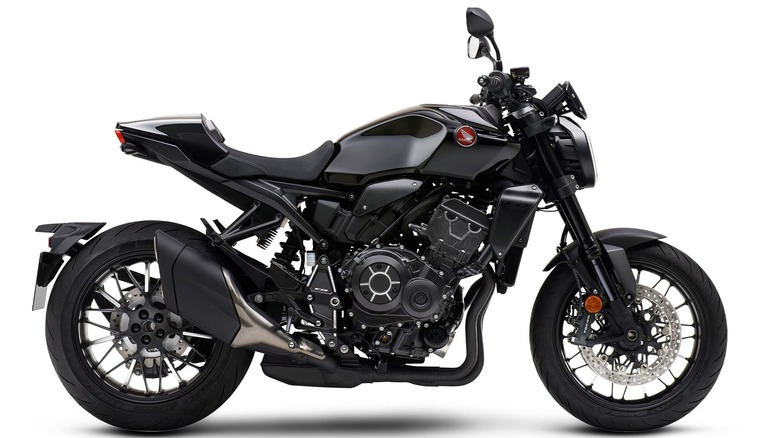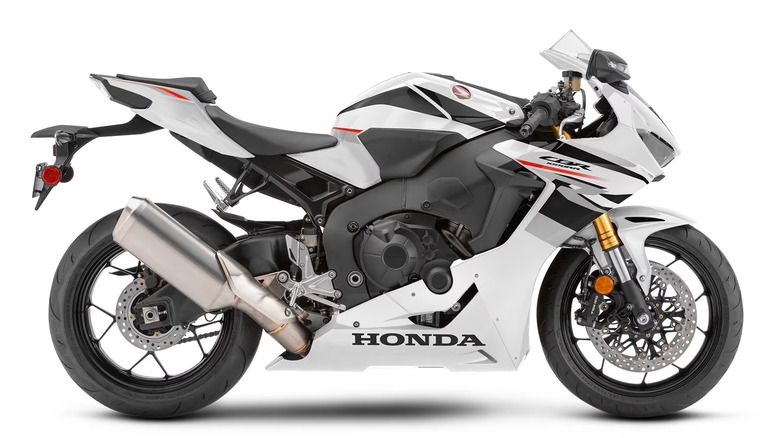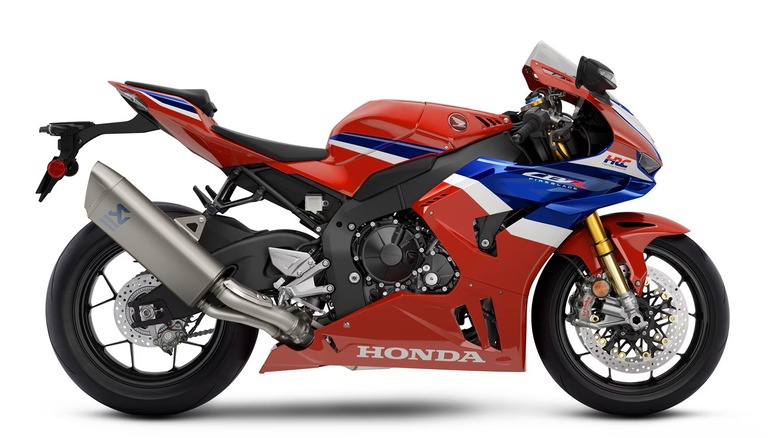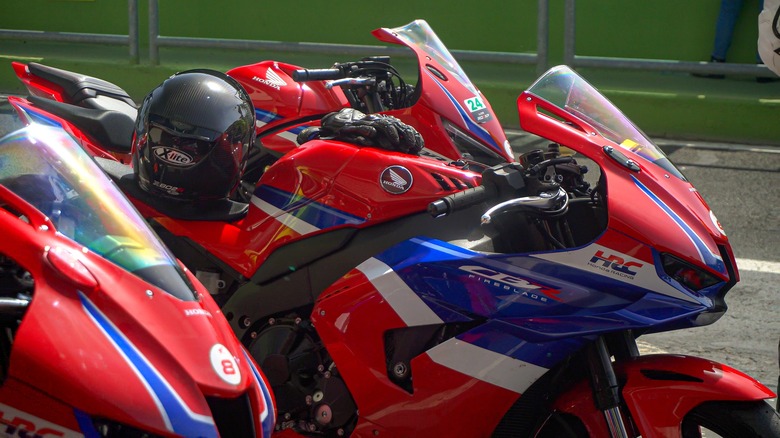Every Honda CB/R Series Motorcycle You Can Buy In 2024 Ranked Cheapest To Most Expensive
Honda has been one of the most legendary motorcycle producers in the world since introducing its A-type motorized bicycle in 1947. Known for quality construction, reliability, and performance, Honda soon found itself mired in competition from the likes of Kawasaki, Yamaha, and Suzuki, to name a few. However, when corporations compete, consumers win. The bikes got better, faster, and more innovative. Then Honda changed the whole game by introducing the CB750 in 1969. Considered the world's first superbike, the CB750 lit a fire beneath motorcycle makers to make the fastest, best-handling bikes possible.
For years, the primary options for superbike lovers were 600, 750, and 1,000cc displacements. As engine technology, material engineering, and building processes advanced, these added to some serious bikes. Not everyone could or wanted to sling a leg over hyperfast and potentially dangerous motorcycles, especially not to learn on — but there was hope on the horizon.
Fast forward through the '80s and '90s into the 2000s, when the rise of Honda's CBR, Yamaha's YZF-R, and Kawasaki's Ninja left superbike fans with more choices than ever. Recently, superbike manufacturers have widened their ranges, giving sport motorcyclists more displacement, performance, and handling choices than ever.
The result in 2024 is a multitude of choices for riders when it comes to Honda's CBR line. From smaller displacement perfect for beginners or track weekends up to screaming literbikes a hair shy of what the pros ride, there's something for everyone. Join us as we look at every Honda CB/R series motorcycle you can buy in 2024, ranked from cheapest to most expensive.
CBR300R $4,899
For years, even the smallest supersport bikes had high barriers to entry. With most builders offering 600cc as the smallest displacement available, starting on a supersport was a big ask for inexperienced riders. Fortunately, the latest trends indicate that the executives at the big four Japanese firms have noticed that a more comprehensive array of options, opening the doors to more potential riders.
Honda was one of the early adopters of this trend, introducing the CBR300R in 2014 as the longer-stroked version of its 250R, which had been on the market since 2011. A decade later and the 250 is gone, leaving the 300 as the entry-level sportbike in Honda's stable.
A wet weight of 354 pounds and a 30.7-inch seat height make the CBR300R something most people can swing a leg over and handle without too much trouble. Shorter or lighter-weight riders with little experience can hop on the 300 without feeling intimidated or like they're trying to get in the saddle of a plow horse.
The double overhead cam (DOHC) single-cylinder 286cc four-stroke makes an estimated 30 horsepower and 20 foot-pounds of torque, likely won't keep an experienced biker entertained for a long time. The upshot is that the weekend warrior or sportbike beginner won't have to worry about accidental wheelies. To compare, when sportbikes started in a 600cc displacement, they often had in the range of 120 horsepower. The result is a competent handling bike suitable for riders often ignored in the supersport wars.
CB300R $5,149
Though the first CBR debuted in 1983, taking much of the attention away from the beloved CB line, Honda did not forget the one that started it all. It has taken many forms over the years, but the CB nameplate is going strong. Its current iteration is a line of naked streetfighters. Not everyone is into the full-fairing look, and the CB exists as a nod to riders seeking performance with a little more comfort and a different aesthetic.
The CB300R lands in the same price range as its full-fairing cousin. That may be because it uses the same single-cylinder, 30 hp power plant. However, the CB300R comes standard with anti-lock brakes (ABS), while the CBR300R requires a $200 upcharge for that option. Another difference is an extra inch in seat height at 31.6 inches, but the CB300R is significantly lighter, weighing in at 316 pounds. A modern, lightweight digital display makes reading crucial information accessible on the go.
The CB300R is primarily aimed at the same crowd as the CBR300R, aesthetic notwithstanding. Lighter, shorter, and beginning sportbike riders should look hard at the CB. The primary difference comes down to looks. With a tubular, exposed frame and a touch of blackout menace, the CB300R might have much in common with the CBR300R, but it presents a much different picture on the street.
CBR500R: $7,399
The 300cc bikes are a great place to start, especially for riders with limited experience, but the truth is that bikes at the bottom of the displacement hierarchy are not for everyone. Those who start on a 300 will likely outgrow it within a season or two. Honda's answer is a step up to 500cc displacement with the CBR500R.
One massive difference between the CBR500R and the 300cc bikes is the addition of a second cylinder. The DOHC, 471 cc liquid-cooled parallel twin, will deliver power and balance entirely differently. It also makes the bike significantly heavier — the 500 tips the scales at 421 pounds wet weight. Part of this is because its gas tank is larger, with a 4.5 gallon capacity, compared to the 300cc models' 2.6 gallon tanks. The extra weight comes with the bonus of an estimated 49 horsepower, which makes it significantly more powerful than its little cousins.
The truth is the 300cc Hondas are outliers geared toward riders with specific skill levels or physical traits. The CBR500R is more in line with the traditional starter bike. It has all the looks and feel of a supersport, enough power to challenge a beginner rider without things getting out of hand, and — do we spy winglets? Just like MotoGP! This thing must be ready for the track!
CB650R $9,399
So you're a fan of the naked look and the CB300R piqued your interest, but you're a bigger or more experienced rider. If that's the case, then the CB650R might fit the bill. The 600cc displacement class has defined middleweight sportbikes for decades. In yesteryear, it was where riders had to start if they wanted to break into supersports. However, along with many smaller displacement sport options, the 650 has become a popular displacement in recent years. To compete with the likes of the SV650 and Ninja 650, Honda promoted its CB650F to the CB650R in 2019.
The 650 is a significant step up from the 500. First, it is the first bike in the current Honda sport line to employ the in-line four-cylinder configuration most commonly associated with supersports. As you might imagine, this comes with a significant upgrade in power. The CB650R is rated at 94 horsepower at 12,000 RPM – enough to get in trouble fast but sufficient to keep experienced riders challenged and entertained for an entire career.
The seat height is in the same range as the previous bikes on this list at 31.9 inches, while its wet weight is 456 pounds. Honda's idea is that motorcycle riders will want to eat up miles, supported by accessory choices that include tank and pillion bags. The CB650R is a bike for riders who want to do everything from carving canyons on the weekend to undergoing multi-state road trips.
CBR650R $9,899
Honda has developed the CBR650R in a bid to make a middleweight CBR that's a little more manageable and comfortable than the 600RR. The headlines on the CBR650R are its improved ergonomics and the debut of Honda's E-clutch for the first time on the 650. The E-clutch is a dual-purpose tool that makes shifting less of a concern for beginner riders by eliminating the need to work the clutch shift peg combo. At the same time, it's available to intermediate or advanced riders as a quick-shift option when riding aggressively.
The CBR650R is no slouch in the power department. The 649cc in-line four makes an estimated 94 horsepower, which is a nice amount when weighed against the 466 pound weight wet. Compared to Yamaha's similarly classed YZF-R7, the CBR650R has a smaller displacement but significantly more power. Food for thought if you're looking for a middleweight to grow into.
The CBR650R has the same approximate specs as the CB650R, but it has a racier, full-fairing aesthetic without the tough-to-tackle tweaky power of the CBR600RR. Honda is not shy about giving potential consumers various choices for all skill levels and desires. The CBR650R is a bike with something to offer for fans of sport bikes from beginner to expert skill levels.
CBR600RR $12,199
Praise the enlightened times we live in. Once upon a time, this insane motorcycle would have been where inexperienced riders had to start on supersports. If the CB650R approaches the boundaries of frightening power, the CBR600RR leaps, screaming into buyer beware.
The Honda website somewhat understates this bike as a racing motorcycle, a term that is somehow inadequate and utterly accurate at the same time. Honda's 600 CBRs have a storied history dating back to the 1987 CBR600F Hurricane. Developing its middleweights through the '90s, Honda debuted the first 600RR in 2003. With 20 years of development behind it, the 2024 CBR600RR is, indeed, a racing motorcycle.
Don't be fooled by the smaller displacement — the CBR600RR clocks in at an estimated 119 horsepower delivered to the rear wheel through a six-speed transmission. The 4.8 gallon gas tank is positioned for premium weight distribution, low and center mass. An electronic steering damper settles down the death wobbles at speed, and dual fuel injectors in each cylinder keep the power through the entire power band. For an extra $1,000, buyers can upgrade to the ABS version for advanced braking performance.
The Honda CBR600RR is both street-legal and a track-terror. It is the epitome of middleweight madness, a syringe of adrenaline that sits in your garage just waiting for you to sling a leg over the saddle.
CB1000R Black Edition $12,999
The CB1000R is Honda's current king of naked sportbikes. Available only in black, with black anodized parts and black plating on the subframe, exhaust, and suspension, the CB1000R Black Edition is nothing short of menacing. This is the CB300R extrapolated to the maximum degree.
The bike's core is a 998cc in-line four-cylinder DOHC engine, making an estimated 143 horsepower. The suspension includes a 43mm Showa SFF-BP front fork and a Showa rear shock. Dual 310mm four-piston front disc brakes and a single 256mm rear disc bring it to a safe stop with the aid of ABS.
It's on the tall end of the Honda spectrum, with a seat height of 32.7 inches. At 472 pounds, it's still light by cruiser standards, but this is not the bike for diminutive or beginner riders. Adjustable quick shifters allow for upshifting at full power, which can be a lot of fun on the twisties. Along with a close-ratio six-speed gearbox, this bike is made to be fast with a focus on comfort.
Not every experience on the CB1000R needs to be extreme. In addition to including selectable torque control and rider modes, Honda opened up the rider triangle (the relative position of the feet, hands, and seat of the rider) to keep the rider more comfortable than they would be on race-oriented sportbikes.
CBR1000RR $16,999 to $17,299
If the CB1000R is the big brother of the CB650R, then the CBR1000RR is the same to the CB600RR. With the same laser focus on race performance, the CBR1000RR was once the king of the Honda pile. Though it has been deposed — more on that below — it is still one of the street's fastest and most furious motorcycles today.
The CBR1000RR comes in two trims: standard at $16,999 and with added ABS at $17,299. Both bikes feature a high-compression, 999cc in-line DOHC flat-plane crank four-cylinder nestled in a lightweight aluminum frame with a fully adjustable Showa suspension. It also features Honda's Selectable Torque Control system, which allows the rider to customize preferred power curves, torque-control levels, wheelie control, and engine-braking specifications, making the literbike more manageable. That's good, because everything else about the CBR1000RR is performance-oriented, including dual-stage fuel injection and a relatively light weight of 432 pounds.
The CBR1000RR is an expert motorcycle with a racing pedigree. It is also one of the premium bikes that Honda, a legendary producer of motorcycles, has to offer, bringing to bear everything Honda has learned in nearly 80 years of production.
CBR1000RR-R Fireblade SP $28,999
Everyone knows that the more Rs there are in a motorcycle's name, the faster it is. That's the only joke we'll make about the Honda CBR1000RR-R Fireblade SP — because we're a little afraid of it.
The 1000R designation used to be the highest a rider could go with a supersport bike. There were the outliers like the Hayabusa, Blackbird, and most recently the Kawasaki Ninja H2R, but somewhere along the way, the liter plus designation arrived. Yamaha has done it with the R1M, and Honda now has a premium liter offering.
So, what sets the Fireblade apart from the CBR1000RR? What do buyers get for the extra $11,700? Brembo brakes, a titanium Akropovic muffler, titanium connecting rods that weigh 50% less than a steel rod, a quick shifter, an estimated 215 horsepower in its most powerful configuration, the same bore and stroke as the RC213V racebike, and an Ohlins smart suspension.
The Fireblade is as decked out as Honda makes a sportbike these days. While it might not be on quite the same level as the Hayabusa or H2R, for Honda fans, it is as serious a motorcycle as they come.
Methodology
One of the most appealing things about motorcycles is the ability to beat a supercar at a fraction of the cost. Shiny, candy-colored racebikes have been one of the most popular genres in motorcycling since they showed up in the 1980s.
Today, full-fairing superbikes aren't the only ones to get the coveted R designations. Companies have widened their lines, making supersports accessible to riders of all shapes, sizes, skills, and experience levels.
We seek to keep up with what's trending in the motorcycle world by outlining how manufacturers assign their R designations. Whether it's a naked streetfighter, a beginning handler, or a liter monster, we run down options by price and performance, so you don't have to. Happy riding!
